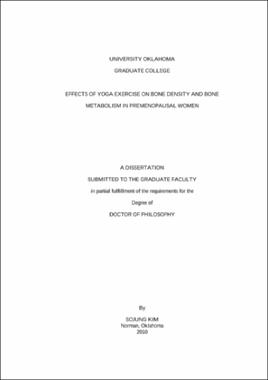| dc.description.abstract | Although the beneficial effects of Yoga for increasing psychological well-being and decreasing stress and reducing cardiovascular risks have been reported, no studies to date have examined intervention Yoga training to investigate its effects on bone metabolism and hormone responses. PURPOSE: The purpose of this study was to examine the effects of an 8 month Yoga exercise program on bone biomarkers, areal bone mineral density (aBMD) for the total body, dual proximal femur, and lumbar spine and volumetric bone mineral density (vBMD) for the tibia and forearm in premenopausal women. A secondary purpose was to examine IGF-I, body composition, and muscular strength changes. METHODS: Thirty-four healthy women were randomly assigned either to a Yoga group (YE, n=16, mean age; mean±SD, 45.73±3.82) or a control group (CON, n=18, 43.22±4.16). Subjects in YE group performed 60 minutes of an Ashtanga Yoga series two times per week with one day between sessions for 8 months in morning sessions (6:30 - 7:30 am, Mondays/Wednesdays). Each Yoga session consisted of 15 minutes of warm-up exercises, 35 minutes of Ashtanga Yoga postures and 10 minutes of cool-down with relaxation. Session intensity was progressively increased during the 8 months. Subjects in CON group did not receive the Yoga exercise intervention, and they were encouraged to maintain their normal daily lifestyle monitored by the bone-specific physical activity questionnaire at 2 month intervals for 8 months. Bone formation (bone alkaline phosphatase, Bone ALP) and bone resorption (tartrate-resistant acid phosphatase, TRAP5b) were assessed at baseline and after Yoga intervention. aBMD and vBMD were measured using DXA and pQCT, respectively. Body composition (DXA) and muscle strength (1RM) for leg press (LP), knee extension (KE), knee flexion (KF), lat pull down (LPD), shoulder press (SP), and biceps curl (BC) were measured. RESULTS: There were no significant differences between the groups in age, height, and weight at baseline. A significant group õ time interaction was detected in serum Bone ALP (p<0.01). Paired samples t-tests indicated that the CON group had a significant decrease in serum Bone ALP concentration. There were also significant group differences (p<0.05) in percent changes for Bone ALP as the YE group had a significantly greater relative increase compared to the CON group (9.1% vs. -7.1%). However, no significant changes were found in TRAP5b in either group after the 8 month Yoga training intervention. There were also no significant group differences (p>0.05) in percent changes for TRAP5b and ratio of Bone ALP to TRAP5b, but there was a trend (p=0.061) for serum TRAP5b, which increased slightly in YE group whereas it decreased in CON group (1.0±4.6% vs. -8.3±6.5%). No significant BMD differences and percent changes were detected in the total body, lumbar spine, and dual femur sites between groups (p>0.05). However, a group õ time interaction was detected (p<0.05) as the radius 33% in YE slightly decreased whereas it increased slightly in the CON group (p<0.05). There were no significant changes in bone content, bone area, cortical thickness, periosteal circumference, and SSI for total, cortical and trabecular at the tibia 4% and 38% (p>0.05). However, a significant time effect was detected (p<0.01) for cortical vBMD at the tibia 66% site as this variable decreased significantly in both groups after the 8 month intervention (-0.3±0.1, YE vs. -0.1±0.1, CON). For the radius 4% and 66%, no changes were detected in vBMD variables except for the trabecular vBMD, which decreased significantly in both groups (p<0.05). The trabecular vBMD of the radius 4% in percent changes were | |
| dc.description.abstract | -4.0±2.4 for the YE group and -2.6%±2.4 for the CON group. A significant time effect was observed (p<0.01) as serum IGF-I levels decreased in both groups after the 8 month intervention (-17.2±4.3%, YE vs. -6.2±4.2%, CON). However, no group õ time interaction was detected (p>0.05). No significant differences and percent changes in weight, total fat mass, and %fat were detected (p>0.05). However, bone free lean body mass in both groups significantly increased (p<0.01); bone free lean body mass in the YE group increased slightly more compared to the CON group (2.1±0.7%, YE vs. 1.9±0.8%, CON). The 8 month Yoga training intervention significantly (p<0.01) increased LP strength in the YE group (p<0.01), whereas LP strength decreased slightly in the CON group. There were also significant group differences (p<0.01) in percent changes for SP as the YE group had a significantly greater relative increase compared to the CON group (7.0±10.7%, YE vs. -2.1±2.7%, CON). However, after adjusting baseline mean differences for SP, one-way ANCOVA did not detect group differences (p>0.05). Also, two-way mixed factorial ANOVA with repeated measures detected a significant time effect (p<0.05) for LPD strength, which significantly decreased LPD muscle strength in both groups. There were no time or group õ time interaction effects were observed for BC, KE, and KF (p>0.05) after the 8 months. CONCLUSION: The findings of this study suggest that the 8 month Ashtanga Yoga was able to generate sufficient mechanical loading forces to elicit increases in bone formation (Bone ALP) as well as increases in leg press muscle strength in premenopausal women. | |
